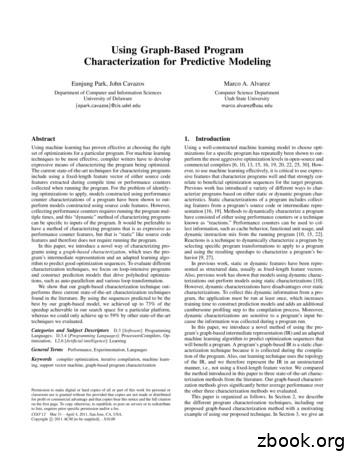Characterization And Factors Associated With Sleep Quality .
time awakea(BD 24, HC 20)No of times awake(BD 24, HC 21)Latency to sleepa(BD 24, HC 21)10.0 1.59.9 1.417.6 35.00.8 1.139.1 62.5BDMeanBD versus HC—weekend nights9.6 1.89.4 2.62.9 6.80.4 0.814.3 16.8HC-0 40.4030.0540.2980.073P valueChild Psychiatry Hum Dev (2011) 42:724–740731123
12318.9NAExcessive/inappropriate guiltaSIB seriousness—non SAaNAPacingPsychomotor retardation0.4NADepressed moodSuicidal ANANA9.57.86.4Weekend nd 24NA0.006NANANA\0.0010.0020.0330.009Weekend night\0.001NA0.0010.002WeeknightP valueIndividual depression variables were not all correlated to each other. Results reflect the following groupings based on significant correlations: (a) PM worse diurnal moodvariation and irritability/anger (P \ .001), (b) irritability/anger and excessive/inappropriate guilt (P .001), (c) excessive/inappropriate guilt, irritability/anger, and selfinjurious behaivor-seriousness-nonSA (P B .001)aPM worse diur mood var PM worse diurnal mood variation, SIB self-injurious behavior, SA suicidal act, NA not associated–0.3Decreased need for sleepCalculated sleepDepressed mood0.443.0Inc in productivityReported sleep41.7NAInc in goal directed activityTotal time awake0.40.5Elation/expansive moodPacingNo. of nighttime awakenings13.9PM worse diur mood varaLatency to sleepWeeknightWeeknightWeekend nightStandard errorEstimated effectTable 5 Association of WASH-U KSADS to sleep variables parent reporting732Child Psychiatry Hum Dev (2011) 42:724–740
Child Psychiatry Hum Dev (2011) 42:724–740733Fig. 1 Average teen reported sleep in hours by ageP .81) or number of times awake (t(22) 0, P 1.0) during weeknights versusweekend nights.Association of WASH-U-KSADS Variables with Sleep QualityTables 5 and 6 present associations of WASH-U KSADS variables with sleep variables asreported by parents and teens. Greater sleep onset latency was associated with parent andteen report of a longer period of worsening evening mood (parent: P .002 for weeknights, P 0.009 for weekend nights, teen: P .025 for weekend nights). Increasingexcessive/inappropriate guilt (P .001 weeknights and P 0.0033 weekend nights) andgreater seriousness of non-suicidal self-injurious behavior (P .002 weekend nights) werealso associated with greater sleep onset latency per parent report. The greater the degree ofmedical lethality of non-suicidal self-injurious behavior (P .026 weekend nights) and agreater feeling of being unloved (P .025 weekend nights) were both associated withlonger sleep onset latency per teen report.Per teen report, increased pacing (P .033 weekend nights) and more psychomotorretardation (P 0.025 weekend nights) were simultaneously associated with greater totalnumber of nighttime awakenings, as was more increased productivity (P .024 weeknights), and a longer period of worsening evening mood (P .015 weeknights). A highernumber of nighttime awakenings (P \ .001 weeknights) was associated with bothincreased pacing (P \ .001 weeknights) and greater elation/expansive mood (P \ .001weeknights) per parent report.Greater total time awake during nighttime awakenings was associated with moredecreased need for sleep (weeknights: P .004 and weekend nights: P .014) and ahigher degree of medical lethality of non-suicidal self-injurious behavior (weeknights andweekend nights: P .001) per teen report. Greater total t
Keywords Bipolar disorder Adolescents Sleep Mood Parent–child report Introduction Pediatric bipolar disorder (BD) is a chronic and debilitating illness associated with frequent mood episode relapse, psychosocial impairment, and substance use [1–7]. . regressed in a stepwise fashion against each slee
Characterization: Characterization is the process by which the writer reveals the personality of a character. The personality is revealed through direct and indirect characterization. Direct characterization is what the protagonist says and does and what the narrator implies. Indirect characterization is what other characters say about the
characterization: direct characterization and indirect characterization. Direct Characterization If a writer tells you what a character is like the method is . Dr. Chang was the best dentist in the practice. He had a charming smile, a gentle manner, and a warm personality.
our characterization. Given this novel characterization, we can pro-duce models that predict optimization sequences that out-perform sequences predicted by models using other characterization tech-niques. We also experimented with other graph-based IRs for pro-gram characterization, and we present these results in Section 5.3.
3. Production Process Characterization 3.1. Introduction to Production Process Characterization 3.1.2.What are PPC Studies Used For? PPC is the core of any CI program Process characterization is an integral part of any continuous improvement program. There are many steps in that program for which process characterization is required. These .
mix were predominantly the major factors influencing the consumers ¶ decision to buy. These was based on durable goods, such as televisions fridge, motor vehicle and etc. Kotler and Armstrong (2007) conducted a research to study factors affecting consumer buying behavior. Amongst all the factors, physical factors, social factors, cultural factors
After distinguishing motivational factors from satisfaction factors, motivational factors should be maintained in a list for further processing while satisfaction factors should be ignored. Step 3: Factors that are not being fulfilled at work place should be short listed. These are the factors that need to be addressed in order to improve the
MODIS Calibration and Characterization for the Reflective Solar Bands (RSB) Jack Xiong and Bill Barnes (NASA/GSFC) RSB Group (MODIS Characterization Support Team) Ocean Color Calibration and Characterization Review Meeting, February 11-12, 2004. Outline EOS Instrument Background
Characterization, Modeling, Monitoring, and Remediation of Fractured Rock: A New Academies Report Author: Sammantha Magsino, National Academies of Science, Engineering, and Medicine Subject: Site Characterization for Effective Remediation Keywords:























